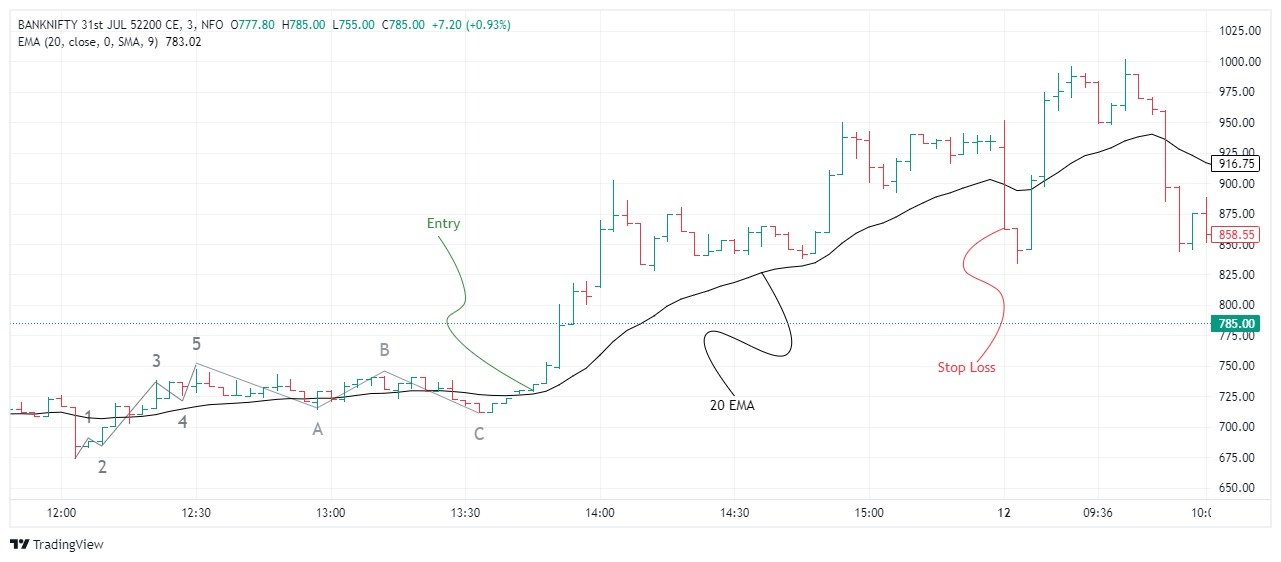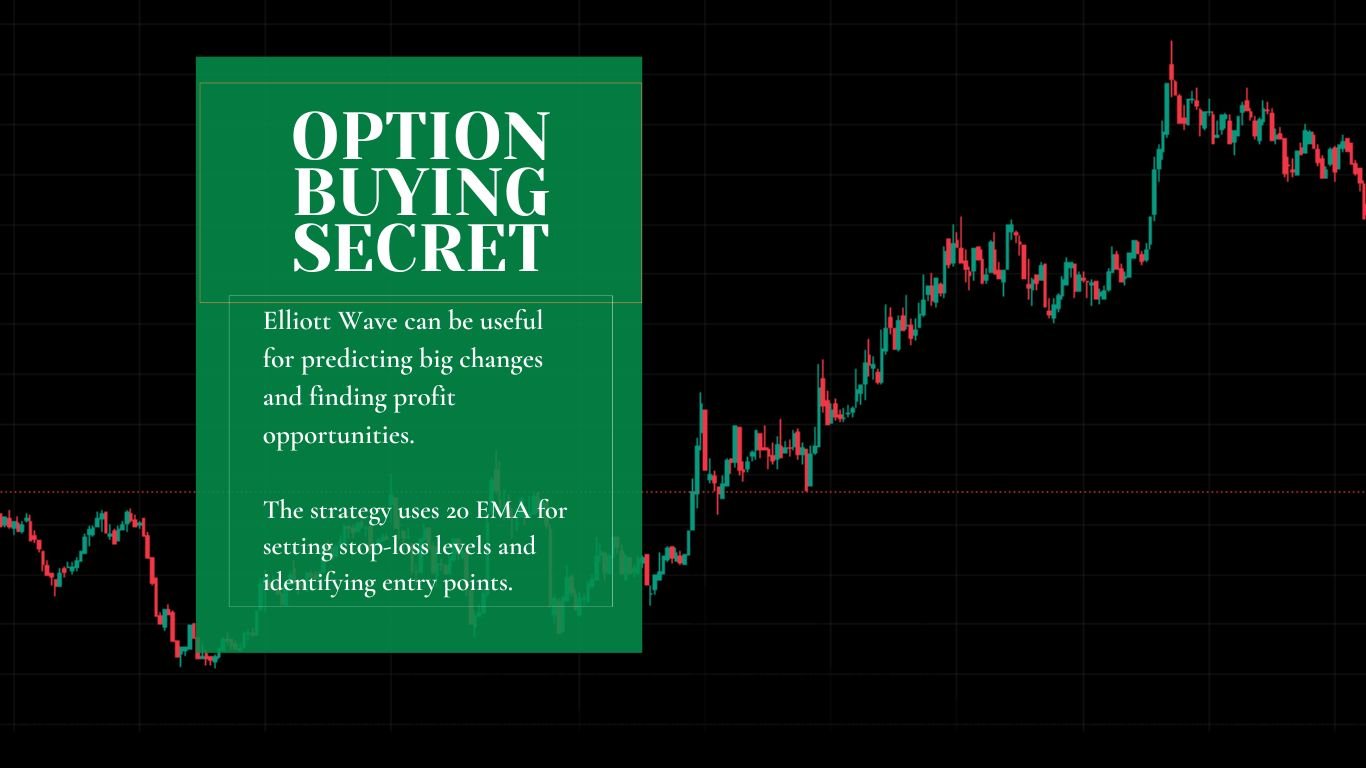Option buying, utilizing Elliott wave theory alongside the Exponential Moving Average (EMA), can forecast significant price movements and enhance profitability. By analyzing impulsive patterns on option charts, traders can make well-informed decisions.
In Short
What is Option Buy?
Have you ever wondered why Option buying is such a popular yet risky trading strategy?
Yes, it’s risky, since prices may swing faster than a trapeze artist! But that’s where the allure is.
Option buying involves strategic decision-making, not just guts. Imagine you’re navigating a maze; you’ll need a clear plan and steel nerves.
That’s where the Elliott Wave and EMA (Exponential Moving Average) methods come in. These tools assist you in analyzing market patterns and trends, allowing you to make better judgments. They’re like your trusted compass and map in the wild world of trading.
Consider combining these strategies: the Elliott Wave for predicting market cycles and the EMA for identifying trends.
It’s like having a crystal ball that shows you where the market may go next. Understanding these techniques and effectively utilizing them will help you improve your chances in this high-stakes game.
Option Buying Secret
Have you ever looked at an Option’s premium chart and wondered how some investors seem to make large gains out of nowhere?
Okay, here’s the scoop: Within the Option chart is a hidden treasure trove of possible profits.
Picture this: Elliott wave theory isn’t only for professionals. It’s similar to having a cheat code that allows you to navigate the market’s ups and downs more easily.
By applying Elliott Wave to Option charts, you may predict large moves before they happen. This predictive capacity has the potential to quickly double or treble the value of a small premium.
Consider the Exponential Moving Average (EMA) to be your trusted friend. While Elliott Wave anticipates large swings, EMA keeps you on the correct track.
A 20-EMA line on your Option chart might help you identify huge profit chances. It’s like having a clear roadmap that stops you from taking unnecessary risks, making Option buying not only exciting but also smart.

BANKNIFTY 52200 CE Exp. July’24/ 3min Chart
When you combine Elliott Wave’s insight with EMA’s advice, you’re not just gambling; you’re strategically preparing yourself for the win.
These techniques help you reduce your risks while increasing your profits, turning Option buying into an activity you can enjoy without holding your breath.
What Is the Trick for Option Buying?
First and foremost, Option charts are more than simply squiggly lines; they are a treasure map. They provide hints that may indicate where the market might go next. Instead of becoming lost in the shuffle, you should learn how to navigate these maps like a veteran explorer.
Now let’s talk about Elliott Wave Theory. You don’t have to be math-savvy to understand its power. Consider it your secret decoder ring for market swings.
Identifying waves and patterns on Option charts allows you to predict strong rallies and major changes before they happen. It’s all about detecting chances before they go.
Have you ever heard of an impulsive move? It’s like a sudden gust of wind that drives prices up or down.
To capture a large rally, you must identify these Impulses hidden in the Option charts. The indications are there; all you need is a keen eye and a willingness to act.
Maximize Profit with Option Buying
When it comes to Option buying, having a strategy is essential. Instead of plunging in headlong, consider it preparation for a treasure hunt. You must study the maps (option charts) and grasp the terrain (market movements). This strategic approach enables you to identify opportunities where others may only perceive risks.
Once you’ve discovered the appropriate setup, you may proceed with confidence.
It is important to be patient during market volatility and disciplined in your approach. Sometimes those who wait for the appropriate moment and adhere to their approach reap the greatest rewards.
Which Strategy Is Best for Option Buying?
Are you interested in the finest Option-buying strategy? Here’s a secret: when you open any Option chart, you can immediately identify a trend. Prices rise significantly at first, then fall for an extended period of time. Then it spends some time circling around the same location.
Following this Corrective phase follows the Motive phase, in which premium prices begin to follow impulsive rules.
When you look at an Option chart following a downturn, you will frequently see the appearance of an impulsive pattern. This impulse might be Wave 1 or A. Wave 2, or Wave 2 or Wave B, is the slight adjustment that comes after that.
Remember that during this downturn, prices never fall below their prior low. In this corrective phase, the prior trend returns, resulting in a quick price movement.
It is about identifying opportunities and making educated judgments that follow the market’s inherent cycles.
Option Buying Strategy with Elliott Wave
It’s like having a hidden blueprint to guide you through the market’s ups and downs. Here’s how to make it work for you:
When you look at an Option chart, you will observe a trend following a corrective period. This pattern often begins with an impulsive motion, either Wave 1 or Wave A. Wave 2, or Wave B, is the subsequent short correction.
After this correction, the original trend resumes, generally with a dramatic price movement.
Here’s when things become interesting. After creating an uptrend, you must await for an Impulse wave. This isn’t a random jump; it’s an indication of outstanding market confidence.
To put it simply, always pay attention to the impulse—it’s your cue to act.
Impulse Wave and Option Chart
When looking at an option chart, an impulse wave is like a sudden surge of energy that drives prices in a particular direction. The Elliott wave theory divides impulses into motive waves. Each impulse wave represents a significant move powered by market sentiment and momentum.
When recognizing impulse waves on Option charts, keep in mind the following significant rules:
An impulse wave typically consists of five sub waves in the direction of the larger trend.
Wave 4 should not overlap with the price zone of Wave 1.
Wave 3 should not be the shortest wave.
Wave 5 can occasionally extend greatly, signaling a last push in the trend’s direction before a possible reversal.
Wave 3 is often the strongest and longest wave, extending beyond the high (or low) of Wave 1.
Profit Booking with the EMA Strategy
When you use the 20 EMA (Exponential Moving Average) on an Option chart, it serves many functions. Its key role is to set stop-loss levels.
Here’s the trick: if a candle closes below the EMA line, then the candle’s low point serves as your stop loss. This allows you to reduce possible losses by riding the trend while also protecting yourself if the market goes against you.
Now, for entry points, EMA crossovers can be invaluable. When the price closes above the 20 EMA, watch for a candle with the high point crossing the EMA line.
The highest point of this crossing candle is where you enter. It indicates a potential shift in momentum that favors upward movement, allowing you to enter the market strategically.
Using the EMA for Stop Loss provides a straightforward and objective technique to control risk. It follows the trend and reacts dynamically to price swings, allowing you to remain disciplined in your trading strategy.
The EMA technique is simple to apply. It simplifies decision-making by focusing on price action relative to a moving average, making it accessible to traders unfamiliar with technical analysis.
How to Use EMA for Options?
When analyzing an Option chart, the EMA can help you identify probable entry positions. Here’s a clever trick: wait for the price to rise over the EMA line following a period of correction. If the price begins to rise before crossing the EMA line, it is a signal for your investment.
Following the EMA crossover, a price increase above previous highs signifies a significant movement. This might indicate a strong rise, which is ideal for capitalizing on possible gains in your Options transaction.
How Do You Buy Options Correctly?
Step-1
Open a premium chart for Options, whether for equities or an index. The price changes on these charts can provide a clear picture of market dynamics.

NIFTY 24600 CE Exp. July’24/ 3min Chart
Step-2
Ensure that an uptrend has begun following an extended downtrend. To confirm an uptrend, check for divergences on the chart after the corrective period.
Step-3
Once you’ve identified the uptrend, search for small-scale impulses within it. These might be defined as Wave 1 to Wave 5 movements, which indicate possible price increases.
Step-4
After recognizing your impulses, wait for a retracement. If the price remains above the preceding impulse’s zero level during this retracement, it indicates that the uptrend is still strong.
Step-5
As the price retraces, look for a crossing above the 20 EMA. This crossing might indicate a continuation of the uptrend. You can enter when the price exceeds the prior high.
Step-6
When starting a trade, always position your stop loss precisely below the EMA line to efficiently control risk. This guarantees that if the market goes against you, your losses are limited.
Following these steps—identifying trends, confirming impulses, and utilizing EMA for entry and risk management—you can improve your trading decisions and increase your chances of making money.
For cryptocurrency investors seeking a systematic and sophisticated approach, the Elliott Wave strategy is an excellent option. The Elliott Wave strategy provides a structured framework for decision-making based on wave patterns and market psychology. Read more…
Final Thought
Understanding Elliott Wave concepts enables you to detect market cycles and forecast upcoming price moves. This allows you to more accurately identify entry and exit positions. The EMA serves as a guidepost, indicating trends and offering information about market momentum. Using EMA crossovers and levels for entry and stop-loss placement improves your trading strategy’s efficiency. Remember, mastering these tactics involves ongoing learning and responding to changing market circumstances. Stay interested, knowledgeable, and practice your abilities to stay ahead in the Options trading game.
As you begin your adventure, keep in mind that effective Options trading requires both technical understanding and rigorous execution. Trust your analysis, handle risk carefully, and always be willing to learn from each transaction. Whether you’re an experienced trader or just starting out, the Elliott Wave and EMA methods provide a solid foundation for navigating the complexity of options markets. Accept the challenge, enjoy the process, and may your deals be successful!
Disclaimer
This article is provided for informational purposes only and does not offer financial advice. Trading and investing involve risk, and past performance is not a guarantee of future outcomes. Before making investment decisions, readers should conduct their own research and consider their individual circumstances. The author and platform are not responsible for any financial losses or damages resulting from the use of this information. Get personalized advice from a trained financial counselor.













Leave a Reply